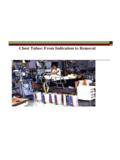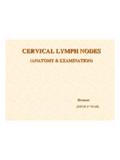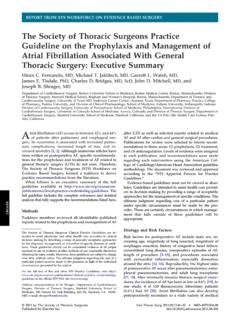Transcription of PREOPERATIVE PULMONARY ASSESSMENT - The Lung Center
1 PREOPERATIVE PREOPERATIVE PULMONARY PULMONARY ASSESSMENTASSESSMENTD efinition Definition -- Postoperative PULMONARY Postoperative PULMONARY complication complication Postoperative PULMONARY complication is Postoperative PULMONARY complication is defined as an abnormalitydefined as an abnormalitythat produces identifiable disease or that produces identifiable disease or dysfunction of the lungsdysfunction of the lungsis clinically significantis clinically significantadversely affects the clinical courseadversely affects the clinical courseMechanismsMechanismsComplications may arise from:Complications may arise from.
2 AtelectasisAtelectasis Infection (Infection (egeg, bronchitis, pneumonia), bronchitis, pneumonia) Prolonged mechanical ventilation and Prolonged mechanical ventilation and respiratory failurerespiratory failure Exacerbation of an underlying chronic Exacerbation of an underlying chronic lung diseaselung disease BronchospasmBronchospasmImportance of Postoperative PULMONARY Importance of Postoperative PULMONARY Complications Complications Increase Increase perioperativeperioperative morbidity and morbidity and mortalitymortalityMore common than cardiac complications in More common than cardiac complications in patients
3 Undergoing elective surgery to the patients undergoing elective surgery to the thorax and upper abdomenthorax and upper abdomenFrequency rate varies from 5 Frequency rate varies from 5--70%70%Prolong the hospital stay by an average of Prolong the hospital stay by an average of one to two weeks one to two weeks PERIOPERATIVE PULMONARY PERIOPERATIVE PULMONARY PHYSIOLOGYPHYSIOLOGYR espiratory effects of general anesthesia Respiratory effects of general anesthesia Decreased respiratory drive causing a Decreased respiratory drive causing a diminished response to both diminished response to both hypercapniahypercapnia and hypoxemiaand hypoxemiaDrugs (neuromuscular blockers, anesthetic Drugs (neuromuscular blockers, anesthetic agents) cause diaphragm and chest wall agents) cause diaphragm and chest wall relaxationrelaxationThis results in a marked reduction in the This results in a marked reduction in the functional reserve capacity (FRC) and functional reserve capacity (FRC)
4 And thereby decreased thoracic volume thereby decreased thoracic volume Respiratory effects of general anesthesiaRespiratory effects of general anesthesiaThe decrease in lung volume promotes The decrease in lung volume promotes atelectasisatelectasis in the dependent lung regions in the dependent lung regions and persists for more than 24 hours in and persists for more than 24 hours in 50% of patients50% of patientsConsequently, Consequently, arterial hypoxemiaarterial hypoxemia occurs occurs from from ventilation perfusion mismatchventilation perfusion mismatch and and increased shunt fractionincreased shunt fractionPostoperative respiratory physiology in Postoperative respiratory physiology in upper abdominal and thoracic surgery upper abdominal and thoracic surgery Diaphragmatic dysfunction, postoperative Diaphragmatic dysfunction, postoperative pain, and splinting reduce VC by 50% and pain.
5 And splinting reduce VC by 50% and FRC by 30% FRC by 30% Following upper abdominal surgery, ribcage Following upper abdominal surgery, ribcage excursions and abdominal expiratory muscle excursions and abdominal expiratory muscle activities decrease due to decreased central activities decrease due to decreased central nervous system output to the nervous system output to the phrenicphrenic nervesnervesPostoperative respiratory physiology in Postoperative respiratory physiology in upper abdominal and thoracic surgery upper abdominal and thoracic surgery Tidal volume is smaller and the respiratory Tidal volume is smaller and the respiratory rate increases (rate increases)
6 (ieie, rapid shallow breathing), rapid shallow breathing)Inhibition of cough and impaired Inhibition of cough and impaired mucociliarymucociliary clearance because of:clearance because of: rapid shallow breathingrapid shallow breathing residual effects of anesthesia and residual effects of anesthesia and postoperative narcoticspostoperative narcoticsRisk of postoperative pneumonia increased Risk of postoperative pneumonia increased Postoperative respiratory physiology in Postoperative respiratory physiology in upper abdominal and thoracic surgery upper abdominal and thoracic surgery Other factors that may contribute to increased Other factors that may contribute to increased respiratory complications.
7 Respiratory complications:Electrolyte imbalance (Electrolyte imbalance (egeg, , hypokalemiahypokalemia, , hypophosphatemiahypophosphatemia, , hypocalcemiahypocalcemia))General debilitationGeneral debilitationUnderlying lung disease (Underlying lung disease (egeg, chronic , chronic obstructive lung disease [COPD])obstructive lung disease [COPD])PATIENT AND PROCEDURE RELATED RISK PATIENT AND PROCEDURE RELATED RISK FACTORSFACTORSP atientPatient--related risk factorsrelated risk factorsAgeAgeAdvanced age is not an independent risk Advanced age is not an independent risk factor for PULMONARY complications factor for PULMONARY complications In a study of patients over 80 years of age, In a study of patients over 80 years of age, overall 30overall 30--day mortality was , patients day mortality was.
8 Patients who belonged to ASA class II had less who belonged to ASA class II had less than 1% mortalitythan 1% mortalityTherefore, surgery should not be declined Therefore, surgery should not be declined on the basis of advanced age aloneon the basis of advanced age alonePatientPatient--related risk factorsrelated risk factorsObesity (BMI > 27 kg/mObesity (BMI > 27 kg/m22))Obesity decreasesObesity decreases Expiratory reserve volumeExpiratory reserve volume Functional residual capacityFunctional residual capacityMorbid obesity causesMorbid obesity causes Restrictive lung diseaseRestrictive lung disease Decreases thoracic complianceDecreases thoracic compliance Leads to alveolar hypoventilationLeads to alveolar hypoventilationPatientPatient--related risk factorsrelated risk factorsSevere obesity is associated with PULMONARY Severe obesity is associated with PULMONARY hypertension, hypertension.
9 Corcor--pulmonalepulmonale and and hypercapnichypercapnic respiratory failure (respiratory failure (PickwickianPickwickian syndrome)syndrome)PatientPatient--relate d risk factorsrelated risk factorsGeneral health statusGeneral health statusPatients who have poor exercise capacity are Patients who have poor exercise capacity are at increased risk of developing postoperative at increased risk of developing postoperative PULMONARY complicationspulmonary complicationsInability to raise heart rate by a simple Inability to raise heart rate by a simple exercise predicts 79% of PULMONARY exercise predicts 79% of PULMONARY complicationscomplicationsPatientPatient --related risk
10 Factorsrelated risk factorsSmokingSmokingCurrent smokers: 2 Current smokers: 2--fold increased risk of fold increased risk of postoperative complicationspostoperative complicationsThe risk is highest in patients who The risk is highest in patients who smoked within the last 2 monthssmoked within the last 2 monthsPatients who quit smoking for more than 6 Patients who quit smoking for more than 6 months have a risk similar to the months have a risk similar to the nonsmokersnonsmokersPostoperative morbidity is not decreased Postoperative morbidity is not decreased in patients who quit smoking for less than in








